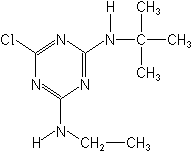-
Common NameTerbuthylazine
-
中文通用名特丁津
-
IUPACN2-tert-butyl-6-chloro-N4-ethyl-1,3,5-triazine-2,4-diamine
-
CAS6-chloro-N-(1,1-dimethylethyl)-N′-ethyl-1,3,5-triazine-2,4-diamine
-
CAS No.5915-41-3
-
Molecular FormulaC9H16ClN5
-
Molecular Structure
-
Category
-
ActivityHerbicide
-
PremixTerbuthylazine+Mesotrione+Propisochlor
S-metolachlor+Terbuthylazine
Nicosulfuron+Terbuthylazine
-
Physical PropertiesMolecular weight:229.7; Physical form:Colourless powder. Density:1.188 (20 °C); Composition:Tech. is ×96 % pure. Melting point:177-179 °C; Flash point:>150 °C; Vapour pressure:0.15 mPa (25 °C); Henry constant:4.05 ×10-3 Pa m3 mol-1 ( calc.); Partition coefficient(n-octanol and water):logP = 3.21 (unionised); pKa:2.0, v. weak base; Solubility:In water 8.5 mg/l ( pH 7, 20 °C). In acetone 41, ethanol 14, n-octanol 12, n-hexane 0.36 (all in g/l, 25 °C).; Stability:Stable in neutral, weakly acidic and weakly alkaline media,in isopropanol about 1%; in dimethylformamide about 10%.; hydrolysed in acidic or alkaline media; DT50 (20 °C) ( calc.) 8 d ( pH 1), 12 d ( pH 13).
-
ToxicologyOral:Acute oral LD50 for rats 1590->2000 mg/kg. Percutaneous:Acute percutaneous LD50 for rats >2000 mg/kg. No skin or eye irritation. Not a skin sensitiser. Inhalation: LC50 (4 h) for rats >5.3 mg/l air. Phytotoxicity:Phytotoxic to many annual plants and to aquatic plants. ADI:0.075 mg/kg b.w.
-
Environmental ProfileEcotoxicology:
Algae: EC50 (72 h) for Scenedesmus subspicatus 0.016-0.024 mg/l.Bees:LD50 (oral and contact) >100 µg/bee.Birds:Acute oral LD50 for ducks and quail >1000 mg/kg. Dietary LC50 (8 d) for ducks and quail >5620 ppm.Daphnia: LC50 (48 h) 21-50.9 mg/l.Fish: LC50 (96 h) for rainbow trout 3.8-4.6, bluegill sunfish 7.5, carp and catfish 7.0 mg/l.Worms: LC50 (7 d) for earthworms >200 mg/kg soil.Other beneficial spp.:No effects on bacterial respiration and nitrification in range 10.9-109 mg/kg soil.
Environmental fate:
Animals:In mammals, following oral administration, 72-84% is eliminated in the urine and faeces within 24 h, and almost all within 48 h. A de-ethyl metabolite forms rapidly, followed by conjugates of products formed by oxidation of one methyl group of the terSoil:Adsorption on soils is strong: Koc 162-278, Kd 2.2-25 are typical values for light agricultural soils. Terbuthylazine is only slightly mobile. Microbial degradation proceeds mainly by de-ethylation aPlant:Triazine-tolerant plants (e.g. maize) rapidly de-chlorinate terbuthylazine to hydroxy-terbuthylazine. Various amounts of de-ethylated and hydroxy de-ethylated metabolites are produced, depending on the plant species. -
Transport InformationSignal Word:CAUTION; Hazard Class:III(Slightly hazardous)
Porduct NewsMore
Syngenta launches herbicide Lumax for corn in Spain
S-metolachlor Mesotrione Terbuthylazine
Related CompaniesMore
Lianyungang Liben Crop Science Co.,Ltd.
Country: China
Terbuthylazine Paraquat Atrazine Ametryn Prometryn Pyraclostrobin Isoprothiolane Simazine Azoxystrobin Chlorpyrifos Nitenpyram
Shanghai Nicex International Trading Co.,Ltd.
Country: China
Oxadiazon Oxadiargyl Azoxystrobin TC Bentazone 2,4-D TC MCPA TC Nicosulfuron Tribenuron-methyl Bispyribac-sodium
Ningxia Lamtin Agricultural Development Co.Ltd.
Country: China
Oxadiargyl Bentazone Oxadiazon Metamifop Propanil
Country: China
Glufosinate-ammonium 2,4-D MCPA Dicamba Propanil Clethodim Glyphosate Captan Flumioxazin Sulfentrazone
Country: China
Copper hydroxide Brassinolide Azoxystrobin Metaldehyde Prohexadione-calcium Adjuvant: Super-spreader Organosilicone PASS Adjuvant: Penetrant-Spreader Pro-MSO Plus Super Absorbent Polymer for Agriculture Pro-SAP Adjuvant: Water Conditioner Pro-Buffer L2

 0
0 Subscribe
Subscribe
